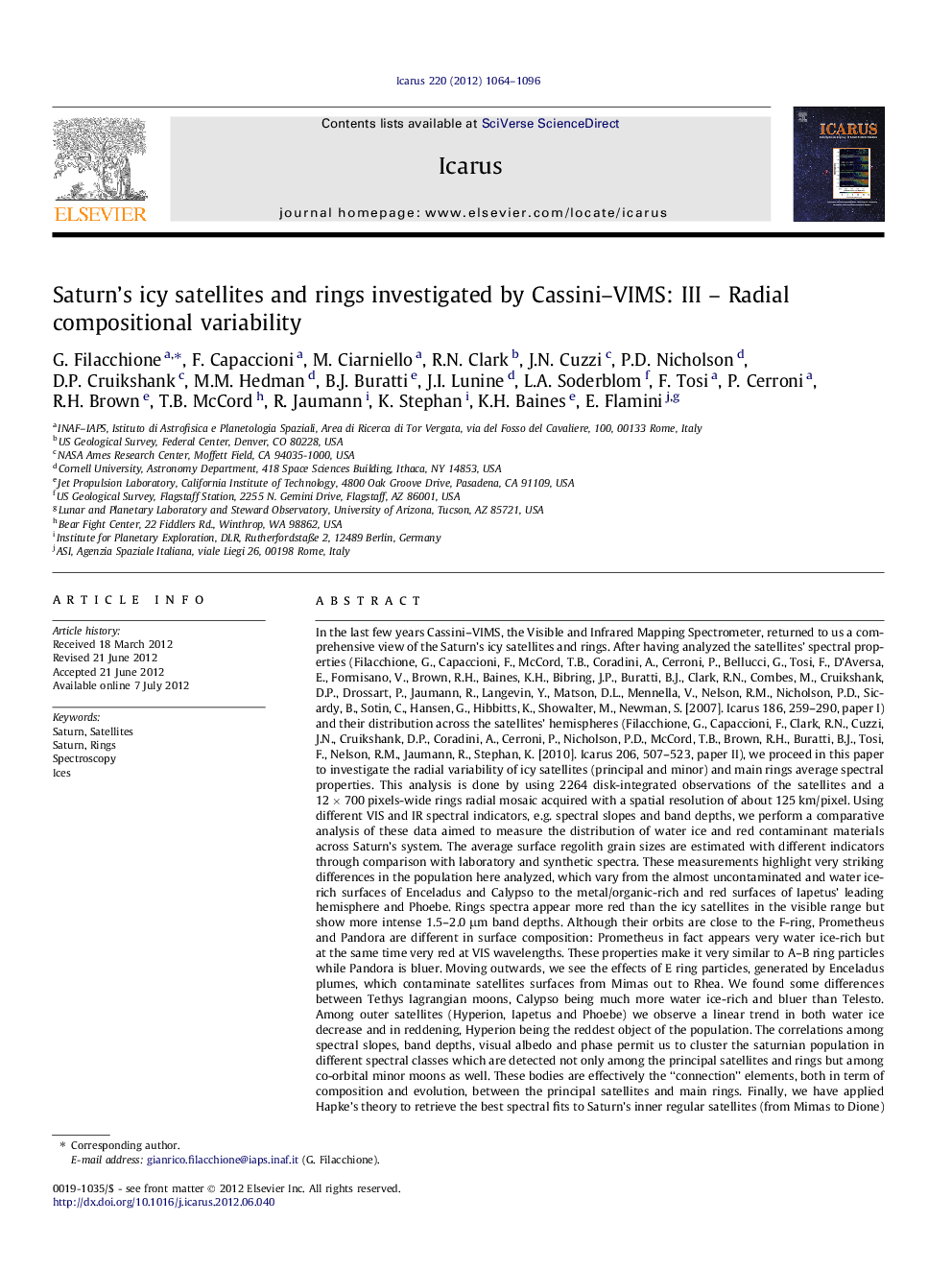| کد مقاله | کد نشریه | سال انتشار | مقاله انگلیسی | نسخه تمام متن |
|---|---|---|---|---|
| 1773464 | 1523564 | 2012 | 33 صفحه PDF | دانلود رایگان |

In the last few years Cassini–VIMS, the Visible and Infrared Mapping Spectrometer, returned to us a comprehensive view of the Saturn’s icy satellites and rings. After having analyzed the satellites’ spectral properties (Filacchione, G., Capaccioni, F., McCord, T.B., Coradini, A., Cerroni, P., Bellucci, G., Tosi, F., D’Aversa, E., Formisano, V., Brown, R.H., Baines, K.H., Bibring, J.P., Buratti, B.J., Clark, R.N., Combes, M., Cruikshank, D.P., Drossart, P., Jaumann, R., Langevin, Y., Matson, D.L., Mennella, V., Nelson, R.M., Nicholson, P.D., Sicardy, B., Sotin, C., Hansen, G., Hibbitts, K., Showalter, M., Newman, S. [2007]. Icarus 186, 259–290, paper I) and their distribution across the satellites’ hemispheres (Filacchione, G., Capaccioni, F., Clark, R.N., Cuzzi, J.N., Cruikshank, D.P., Coradini, A., Cerroni, P., Nicholson, P.D., McCord, T.B., Brown, R.H., Buratti, B.J., Tosi, F., Nelson, R.M., Jaumann, R., Stephan, K. [2010]. Icarus 206, 507–523, paper II), we proceed in this paper to investigate the radial variability of icy satellites (principal and minor) and main rings average spectral properties. This analysis is done by using 2264 disk-integrated observations of the satellites and a 12 × 700 pixels-wide rings radial mosaic acquired with a spatial resolution of about 125 km/pixel. Using different VIS and IR spectral indicators, e.g. spectral slopes and band depths, we perform a comparative analysis of these data aimed to measure the distribution of water ice and red contaminant materials across Saturn’s system. The average surface regolith grain sizes are estimated with different indicators through comparison with laboratory and synthetic spectra. These measurements highlight very striking differences in the population here analyzed, which vary from the almost uncontaminated and water ice-rich surfaces of Enceladus and Calypso to the metal/organic-rich and red surfaces of Iapetus’ leading hemisphere and Phoebe. Rings spectra appear more red than the icy satellites in the visible range but show more intense 1.5–2.0 μm band depths. Although their orbits are close to the F-ring, Prometheus and Pandora are different in surface composition: Prometheus in fact appears very water ice-rich but at the same time very red at VIS wavelengths. These properties make it very similar to A–B ring particles while Pandora is bluer. Moving outwards, we see the effects of E ring particles, generated by Enceladus plumes, which contaminate satellites surfaces from Mimas out to Rhea. We found some differences between Tethys lagrangian moons, Calypso being much more water ice-rich and bluer than Telesto. Among outer satellites (Hyperion, Iapetus and Phoebe) we observe a linear trend in both water ice decrease and in reddening, Hyperion being the reddest object of the population. The correlations among spectral slopes, band depths, visual albedo and phase permit us to cluster the saturnian population in different spectral classes which are detected not only among the principal satellites and rings but among co-orbital minor moons as well. These bodies are effectively the “connection” elements, both in term of composition and evolution, between the principal satellites and main rings. Finally, we have applied Hapke’s theory to retrieve the best spectral fits to Saturn’s inner regular satellites (from Mimas to Dione) using the same methodology applied previously for Rhea data discussed in Ciarniello et al. (Ciarniello, M., Capaccioni, F., Filacchione, G., Clark, R.N., Cruikshank, D.P., Cerroni, P., Coradini, A., Brown, R.H., Buratti, B.J., Tosi, F., Stephan, K. [2011]. Icarus 214, 541–555).
► 2298 VIMS observations of Saturn’s satellites and one ring mosaic are analyzed.
► Average spectral properties of the system, from the C ring to Phoebe, are retrieved.
► The saturnian population is clustered in different spectral/compositional classes.
► Application of Hapkes theory to model inner regular satellites spectra.
Journal: Icarus - Volume 220, Issue 2, August 2012, Pages 1064–1096